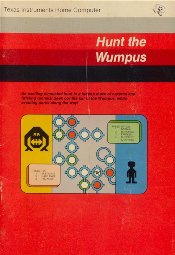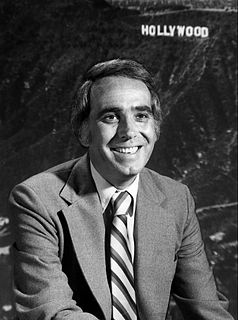Related Research Articles

Hunt the Wumpus is a text-based adventure game developed by Gregory Yob in 1973. In the game, the player moves through a series of connected caves, arranged as the vertices of a dodecahedron, as they hunt a monster named the Wumpus. The turn-based game has the player trying to avoid fatal bottomless pits and "super bats" that will move them around the cave system; the goal is to fire one of their "crooked arrows" through the caves to kill the Wumpus. Yob created the game in early 1973 due to his annoyance at the multiple hide-and-seek games set in caves in a grid pattern, and multiple variations of the game were sold via mail order by Yob and the People's Computer Company. The source code to the game was published in Creative Computing in 1975 and republished in The Best of Creative Computing the following year.

The Magnavox Odyssey 2, also known as Philips Odyssey 2, is a second generation home video game console that was released in 1978. It was sold in Europe as the Philips Videopac G7000, in Brazil and Peru as the Philips Odyssey and in Japan as Odyssey2. The Odyssey 2 was one of the four major home consoles prior to the 1983 video game market crash, along with Atari 2600, Intellivision and ColecoVision.

The Atari 8-bit family is a series of 8-bit home computers introduced by Atari, Inc. in 1979 as the Atari 400 and Atari 800. The series was successively upgraded to Atari 1200XL, Atari 600XL, Atari 800XL, Atari 65XE, Atari 130XE, Atari 800XE, and Atari XEGS, the last discontinued in 1992. They differ primarily in packaging, each based on the MOS Technology 6502 CPU at 1.79 MHz and the same custom coprocessor chips. As the first home computer architecture with coprocessors, it has graphics and sound more advanced than most contemporary machines. Video games were a major draw, and first-person space combat simulator Star Raiders is considered the platform's killer app. The plug-and-play peripherals use the Atari SIO serial bus, with one developer eventually also co-patenting USB.

The Oregon Trail is a text-based strategy video game developed by Don Rawitsch, Bill Heinemann, and Paul Dillenberger in 1971 and produced by the Minnesota Educational Computing Consortium (MECC) beginning in 1975. It was developed as a computer game to teach school children about the realities of 19th-century pioneer life on the Oregon Trail. In the game, the player assumes the role of a wagon leader guiding a party of settlers from Independence, Missouri, to Oregon City, Oregon via a covered wagon in 1847. Along the way the player must purchase supplies, hunt for food, and make choices on how to proceed along the trail while encountering random events such as storms and wagon breakdowns. The original versions of the game contain no graphics, as they were developed for computers that used teleprinters instead of computer monitors. A later Apple II port added a graphical shooting minigame.

William Murray "Trip" Hawkins III is an American entrepreneur and founder of Electronic Arts, The 3DO Company, and Digital Chocolate.

Star Trek is a text-based strategy video game based on the Star Trek television series and originally released in 1971. In the game, the player commands the USS Enterprise on a mission to hunt down and destroy an invading fleet of Klingon warships. The player travels through the 64 quadrants of the galaxy to attack enemy ships with phasers and photon torpedoes in turn-based battles and refuel at starbases. The goal is to eliminate all enemies within a random time limit.

Thomas James Snyder was an American television personality, news anchor, and radio personality best known for his late night talk shows Tomorrow, on the NBC television network in the 1970s and 1980s, and The Late Late Show, on the CBS Television Network in the 1990s. Snyder was also the pioneer anchor of the prime time NBC News Update, in the 1970s and early 1980s, which was a one-minute capsule of news updates in prime time.

Creative Computing was one of the earliest magazines covering the microcomputer revolution. Published from October 1974 until December 1985, the magazine covered the spectrum of hobbyist/home/personal computing in a more accessible format than the rather technically oriented Byte.

Junichi Masuda is a Japanese video game composer, director, designer, producer, singer, programmer and trombonist, best known for his work in the Pokémon franchise. He was a member of Game Freak where he was an employee and executive at the company since 1989 when he founded it alongside Satoshi Tajiri and Ken Sugimori. In 2022, Masuda was appointed to be Chief Creative Fellow at The Pokémon Company.

Science Court is an educational entertainment, animation/non-traditional court show from Tom Snyder Productions, which was aired on ABC's Disney's One Saturday Morning block from 1997 to 2000. The cartoon was "filmed" in Squigglevision.

Soup2Nuts was an American animation studio founded by Tom Snyder. The studio is known for its animated comedy series, its use of Squigglevision, a technique of animation that reuses frames to make the animation look more kinetic, and for its style of improvisation in voice acting.

Evan Fong, known online as VanossGaming, is a Canadian internet personality, video game commentator, music producer, and DJ. He posts montage-style videos on YouTube of him and other creators playing various video games, such as Grand Theft Auto V and Garry's Mod. Aside from this, he produces music and performs as a DJ under the name Rynx, and served as a creative director for the video game Dead Realm, and as a voice actor for the YouTube Premium series Paranormal Action Squad and the animated series Alpha Betas.
Madeline is a series of educational point-and-click adventure video games which were developed during the mid-1990s for Windows and Mac systems. The games are an extension of the Madeline series of children's books by Ludwig Bemelmans, which describe the adventures of a young French girl. The video-game series was produced concurrently with a TV series of the same name, with characters and voice actors from the show.
The Oregon Trail is a series of educational computer games. The first game was originally developed by Don Rawitsch, Bill Heinemann, and Paul Dillenberger in 1971 and produced by the Minnesota Educational Computing Consortium (MECC) in 1974. The original game was designed to teach 8th grade schoolchildren about the realities of 19th-century pioneer life on the Oregon Trail. The player assumes the role of a wagon leader guiding a party of settlers from Independence, Missouri, to Oregon's Willamette Valley via a covered wagon in 1848.
Decisions, Decisions is a 15-part educational role-playing video game series by Tom Snyder Productions, released from the 1980s to the early 2000s. It has also been described as a "media-assisted simulation game" series.
The Search Series is a five-game series of educational video games by Tom Snyder Productions and published by McGraw-Hill Education in 1980. It runs on either Apple II or Radio Shack Models I and III.

Science Seekers is a trilogy of science-related educational video games for the Windows and Macintosh platforms, developed and published by Tom Snyder Productions. The American Museum of Natural History collaborated in the series' development and got a grant from NASA. The series consists of Science Seekers: Hidden in Rocks, Science Seekers: Endangered Species and Science Seekers: Safe Water.

Fizz & Martina's Math Adventures is a collection of five math-related educational video games for the Windows and Macintosh platforms, developed and published by Tom Snyder Productions. The games were incorporated with the California Learning Assessment System (CLAS). The series consists of Buddies for Life, Blue Falls Elementary, Caves of Blue Falls, Lights, Camera, Fractions! and Project Sphinx.

The Oregon Trail is an educational strategy video game developed and published by the Minnesota Educational Computing Consortium (MECC). It was first released in 1985 for the Apple II, with later ports to DOS in 1990, Mac OS in 1991, and Microsoft Windows in 1993. It was created as a re-imagining of the popular text-based game of the same name, originally created in 1971 and published by MECC in 1975. In the game, the player assumes the role of a wagon leader guiding a party of settlers from Independence, Missouri, to Oregon's Willamette Valley via a covered wagon on the Oregon Trail in 1848. Along the trail, the player makes choices about supplies, resource management, and the route, and deals with hunting for food, crossing rivers, and random events such as storms and disease.

The Sumerian Game is a text-based strategy video game of land and resource management. It was developed as part of a joint research project between the Board of Cooperative Educational Services of Westchester County, New York and IBM in 1964–1966 for investigation of the use of computer-based simulations in schools. It was designed by Mabel Addis, then a fourth-grade teacher, and programmed by William McKay for the IBM 7090 time-shared mainframe computer. The first version of the game was played by a group of 30 sixth-grade students in 1964, and a revised version featuring refocused gameplay and added narrative and audiovisual elements was played by a second group of students in 1966.
References
- 1 2 3 "Tyrone Daily Herald from Tyrone, Pennsylvania on September 6, 1984 · Page 2". Newspapers.com. Retrieved 2018-03-19.
- 1 2 3 "Profile of a snooper trooper". Creative Computing . Vol. 9, no. 4. Ahl Computing, Inc. April 1983. p. 130. ISSN 0097-8140 . Retrieved March 20, 2018.